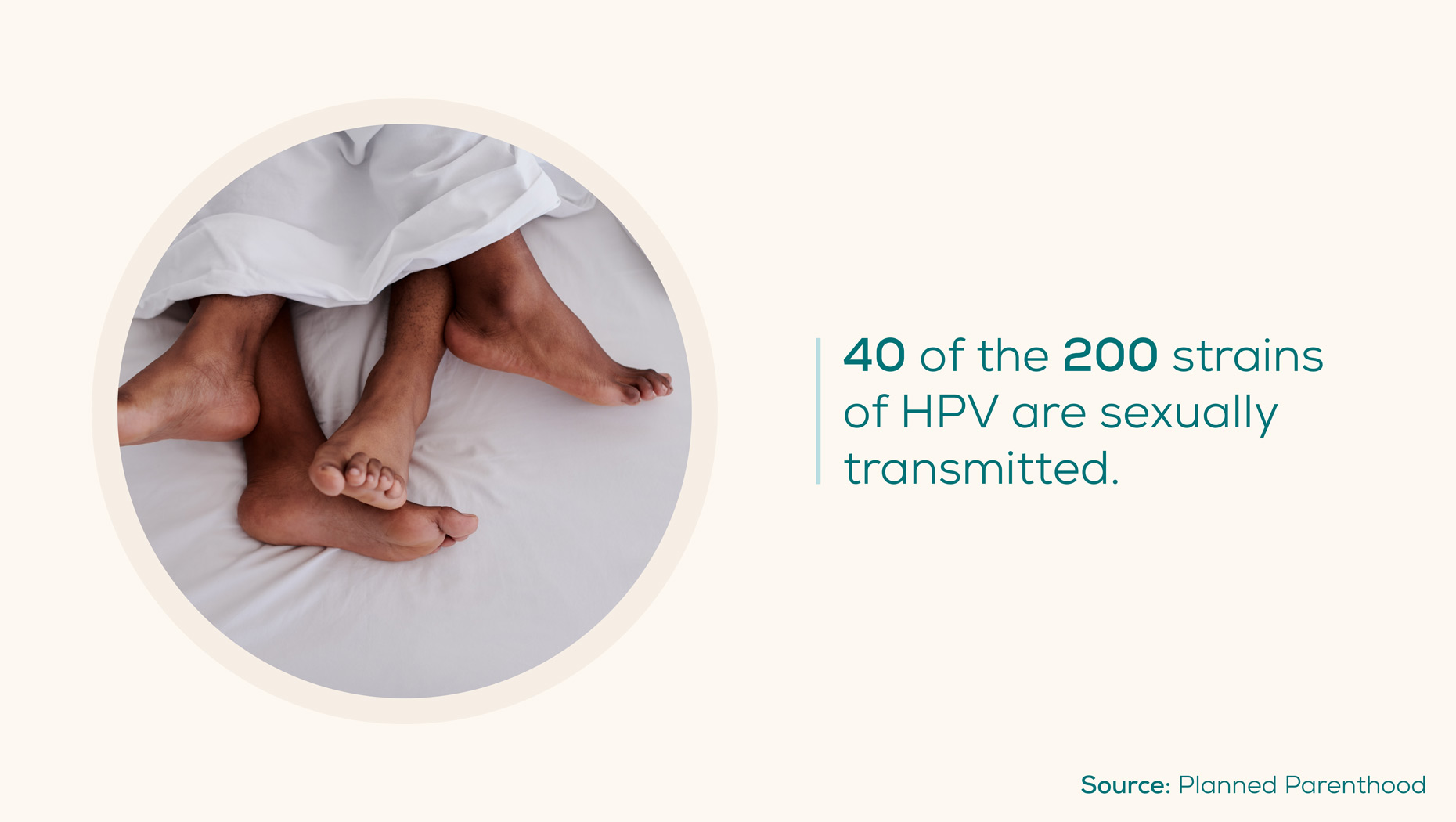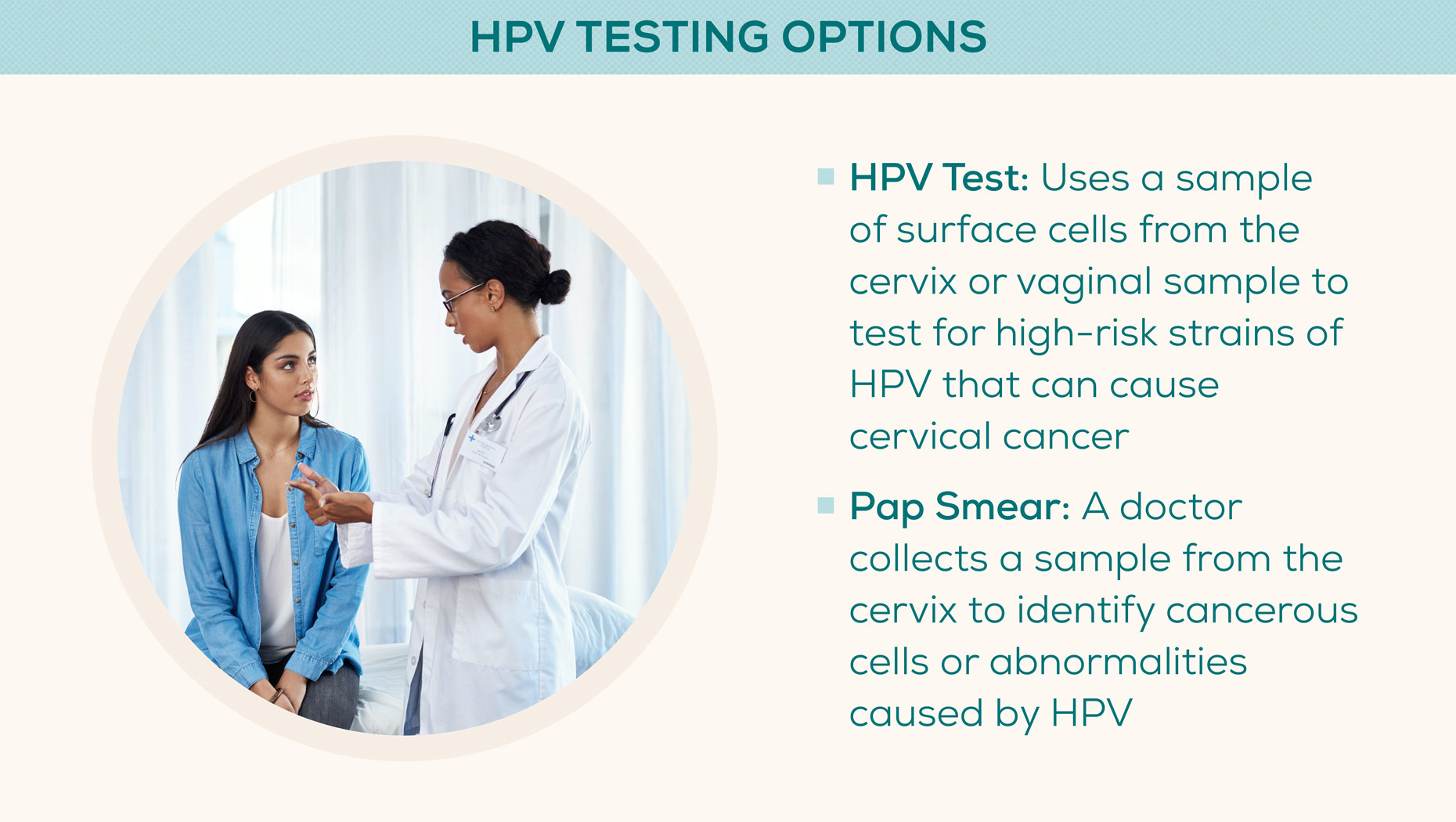
What Is HPV and How Is It Transmitted?
Medically reviewed on April 19, 2022 by Jordan Stachel, M.S., RDN, CPT. To give you technically accurate, evidence-based information, content published on the Everlywell blog is reviewed by credentialed professionals with expertise in medical and bioscience fields.
Human papillomavirus (HPV) is the most common STI in the United States, affecting 79 million people each year. If you're sexually active, there's a good chance that you'll come into contact with it at least once in your lifetime.
There are many different strains of HPV, and their symptoms and associated risk factors can vary depending on which type you have. Each strain fits into one of two categories: high risk or low risk. While both types rarely show symptoms, high-risk types can increase your risk of developing cervical and other cancers.
One of the most important things you can do to protect yourself and others from contracting HPV is to learn how it spreads and take safety precautions to prevent transmission.
Read on to learn more about HPV transmission and how you can protect yourself.
Table of Contents
- How Is HPV Transmitted?
- HPV Symptoms and Risk Factors
- How To Test for HPV
- Treatment Options
- How To Protect Yourself
- Additional Resources
How Is HPV Transmitted?
Sexually transmitted HPV is commonly spread during vaginal, anal, or oral sex but can also spread through close skin-to-skin contact with an infected partner. While 40 of the 200 strains of HPV are sexually transmitted, some other types only affect the hands or feet and can spread through casual skin-to-skin contact or contact with an object or surface. These types are commonly associated with common and plantar warts.
One of the most important things to remember about HPV is that a person can still spread it even if they aren’t showing any symptoms. If you are sexually active, you should always discuss the risks and testing options with your partner.

HPV Symptoms and Risk Factors
Nine out of 10 HPV cases clear on their own within two years without causing any health issues. However, HPV infections can cause symptoms to develop if they don’t go away on their own. Some of the most common signs and risk factors to be aware of include:
Genital Warts
Most cases of genital warts are caused by HPV types 6 and 11. Genital warts are small, skin-colored bumps or cauliflower-shaped skin growths that can appear on the vagina, vulva, cervix, scrotum, penis, or anus. Due to their similar appearance, they can sometimes be mistaken for skin lesions caused by genital herpes.
While genital warts can cause irritation and discomfort, they are relatively harmless. HPV types 6 and 11 are low-risk strains, meaning that they aren’t dangerous and won’t lead to cancer. That said, you can still pass these strains to a sexual partner, so it’s important to see a healthcare provider for proper diagnosis and treatment if you suspect you have them.
Cancer
While most HPV infections go away on their own without causing any issues, high-risk strains can cause abnormal cell changes and increase the risk of developing certain types of cancer. HPV is most commonly associated with cervical cancer but can cause cancerous cells to develop in the vagina, vulva, penis, anus, or back of the throat. It’s estimated that high-risk HPV causes more than 95 percent of cervical cancers, 90 percent of anal cancers, and 60 percent of penile cancers each year.

High-risk types of HPV sometimes clear on their own, and many precancerous lesions go away spontaneously without intervention. Cervical cancer also takes many years to develop, allowing regular screenings and Pap tests to identify abnormal cells early while they are still easily treatable.
Common Warts
Some strains of HPV that are not sexually transmitted can cause other types of warts to develop, like common, plantar, and flat warts. Flat warts can appear anywhere on the body and look like raised growths with a flat top. Common warts, on the other hand, are raised bumps that typically appear on the hands or fingers, and plantar warts are rough lesions that affect the heels and balls of your feet.
While these warts can cause mild pain and discomfort, they are not dangerous and often go away on their own over time. Healthcare providers may also recommend freezing therapy, laser treatments, minor surgery, or peeling medicine to help clear them up sooner.
HPV and Pregnancy
If you find out that you have HPV while pregnant, there’s no need to panic. While it is possible to pass HPV along to the baby during delivery, it is fairly uncommon and rarely results in any adverse health effects. HPV infection during pregnancy may be linked to laryngeal papillomatosis (a noncancerous growth in the larynx) in newborns, but this condition is very rare.
Hormone changes during pregnancy can increase the size and frequency of genital warts caused by HPV, and large warts can complicate vaginal delivery in some cases. If they are large enough to partially block the birth canal, your healthcare provider may recommend a cesarean section to avoid added stress or discomfort.
How To Test for HPV
Scientists have not yet developed tests for HPV affecting the exterior genitals, but there are screening options for high-risk strains that can cause cervical cancer. If you have a cervix at risk of developing cervical cancer from HPV, Pap smears and HPV tests are the best options for detecting any abnormalities before they become life-threatening.

Pap Smear
While Pap smears are not designed to identify HPV directly, they can test for cancerous and precancerous cells in the cervix caused by high-risk HPV infections. To perform this test, a medical professional gently inserts a speculum into the vagina to view the cervix and uses a small brush to collect a sample of cervical cells. They later view the sample under a microscope to identify any cancerous cells or abnormal changes that could lead to cancer.
If your results come back normal, your doctor may recommend that you schedule another Pap test in three to five years. If your results come back abnormal, however, you may need to schedule a follow-up appointment with a specialist for a biopsy or colposcopic exam.
HPV Test
A healthcare provider uses a very similar method for HPV testing as they would for a Pap smear. After collecting surface cells from the cervix, the healthcare provider sends the sample to a lab to test them for high-risk strains of HPV, like types 16 and 18. A positive result doesn’t mean that you have cervical cancer, but it does indicate that you are at a higher risk. Your healthcare provider may recommend further or more frequent testing to screen for any abnormal cell changes.
If you are uncomfortable with going to a healthcare provider's office or would rather perform the test yourself, you can order an at-home HPV test that includes a vaginal swab from Everlywell. These tests come with clear, easy-to-understand instructions and can identify 14 different genotypes of high-risk HPV. If your test comes back positive, you should schedule an appointment with your healthcare provider for further testing and treatment options.
Treatment Options
While there is currently no cure for HPV, it often clears on its own before you know you have it. If you develop symptoms like genital warts or HPV-related cancers, they can be managed or treated by a medical professional.
- Genital warts: Your healthcare provider may recommend surgical removal or topical prescription medication to treat genital warts that don’t go away on their own. Common surgical options include cryotherapy, laser treatments, and surgical excision.
- Cervical cancer: Cervical cancer is highly treatable if detected early. If your healthcare provider detects precancerous cells in your cervix, they may recommend cryotherapy and the loop electrosurgical excision procedure (LEEP) to remove them. Early and later stages of cervical cancer can often be treated through chemoradiotherapy, radical hysterectomy, and other surgical procedures.
- Other HPV-related cancers: All HPV-related cancers are most treatable when detected early. While most are treated in the same way as non-HPV-related cancers, researchers are currently conducting clinical trials to determine whether HPV vaccine therapy is effective in killing tumor cells and treating anal and vulvar lesions.
How To Protect Yourself
Most people will come into contact with HPV at some point in their lives. However, there are several steps you can take to reduce your risk of contracting the virus and developing HPV-related cancers.
Get an HPV Vaccine
One of the best ways to prevent yourself from contracting the virus is to get the HPV vaccine called Gardasil 9. This vaccine is safe for everyone, regardless of sex, and protects against many strains, including those that cause cancer and genital warts. Though it’s best to get the vaccine before being exposed to HPV, it can still protect previously infected people against strains they haven’t been exposed to yet.
Gardasil 9 is approved for people ages 9 and up, and the CDC recommends that children ages 11 to 12 receive two doses of the vaccine 6–12 months apart. Once they turn 15, however, they will need to be administered three doses over a period of six months. This rule applies until a person turns 27, after which healthcare providers advise against getting the vaccine.
The CDC also advises that you avoid the vaccine if you are pregnant and wait to receive any second or third doses until after you have given birth. If you’re interested in receiving the HPV vaccine or are unsure whether it’s right for you, you should talk to your healthcare provider to discuss your options.
Schedule Regular Screenings
Scheduling regular Pap smears and HPV tests helps detect high-risk strains and precancerous cells as early as possible. How often you should get tested depends on your age, medical history, and your last test date.
Planned Parenthood recommends getting an HPV test every three years if you’re between the ages of 21 and 24 and every five years from ages 25 to 65. These tests can be scheduled at the same time as your regular Pap smear to help simplify the process. However, you may need more frequent testing if you have a weak immune system, have had cervical health issues in the past, or your mother took a medication called DES while she was pregnant with you.
Healthcare providers typically recommend getting a Pap smear every three years from ages 21 to 65. If you are at least 30 and regularly get a Pap smear and HPV test at the same time, you may be able to get both every five years. That said, some healthcare providers recommend getting more frequent Pap tests if your results have been abnormal in the past, you have HIV, or you have a weakened immune system or history of smoking. When in doubt, it’s always best to ask your healthcare provider what is right for you.
Use Condoms and Dental Dams
If you are sexually active, using condoms and dental dams each time you have sex can lower your risk of contracting the virus and developing symptoms like genital warts. That said, these methods become less effective if used incorrectly or inconsistently. To ensure that they work as intended, it’s always a good idea to discuss the risks with your partner and make sure that you both know how to use these products ahead of time.
Additional Resources
If you’ve been exposed to HPV or are looking for more information on treatment and prevention strategies, the following resources and guides can help.
- CDC Resources, Education, and References for HPV Vaccination
- Johns Hopkins HPV resource page
- HPV Treatment and Care Guide
- HPV Facts and Brochures
- U.S. Department of Health and Human Services: HPV
- Understanding Cervical Changes: A Health Guide
You may not experience any symptoms if you are infected with HPV, so it’s important to get screened regularly and take the proper steps to protect yourself. If you suspect that you might have been exposed to HPV, consider talking to your healthcare provider to schedule a screening or test yourself from the comfort of your home with the Everlywell HPV Test.
Article Sources
- Genital HPV Infection – Fact Sheet. Centers for Disease Control and Prevention. URL. Accessed March 30, 2022.
- HPV (Human Papillomavirus). Cleveland Clinic. URL. Accessed March 30, 2022.
- Human Papillomavirus (HPV). Planned Parenthood. URL. Accessed March 30, 2022.
- HPV Infection. Mayo Clinic. URL. Accessed March 30, 2022.
- How Many Cancers Are Linked with HPV Each Year? Centers for Disease Control and Prevention. URL. Accessed March 30, 2022.
- Cervical Cancer. World Health Organization. URL. Accessed March 30, 2022.
- HPV and Cancer. National Cancer Institute. URL. Accessed March 30, 2022.
- Human Papillomavirus (HPV) Perinatal Transmission and Risk of HPV PersistenceAmong Children Papillomavirus Research Journal. URL. Accessed March 30, 2022.
- STDs During Pregnancy – CDC Fact Sheet. Centers for Disease Control and Prevention. URL. Accessed March 30, 2022.
- Pap Smear. National Cancer Institute Dictionary of Cancer Terms. URL. Accessed March 30, 2022.
- Human Papillomavirus (HPV) Infection. Centers for Disease Control and Prevention. URL. Accessed March 30, 2022.
- Genital Warts. Mayo Clinic. URL. Accessed March 30, 2022.
- Treating Cervical Cancer. American Cancer Society. URL. Accessed March 30, 2022.
- How is HPV Treated? Planned Parenthood. URL. Accessed March 30, 2022.
- Therapy of Human Papillomavirus-Related Disease. Vaccine: HPV and Disease Prevention 2012. URL. Accessed March 30, 2022.
- HPV Vaccine Therapy in Interrupting Progression in Patients with High-Grade Vulvar or Anal Lesions. National Cancer Institute. URL. Accessed March 30, 2022.
- HPV Vaccine. Centers for Disease Control and Prevention. URL. Accessed March 30, 2022.
- HPV Vaccine Information for Young Women. Centers for Disease Control and Prevention. URL. Accessed March 30, 2022.
- Should I get Tested for HPV? Planned Parenthood. URL. Accessed March 30, 2022.
- Pap Smear. Mayo Clinic. URL. Accessed March 30, 2022.
- How Do You Prevent HPV? Planned Parenthood. URL. Accessed March 30, 2022.